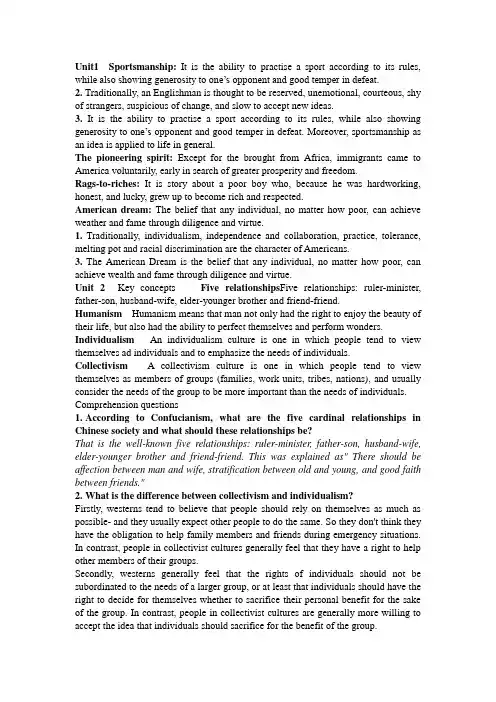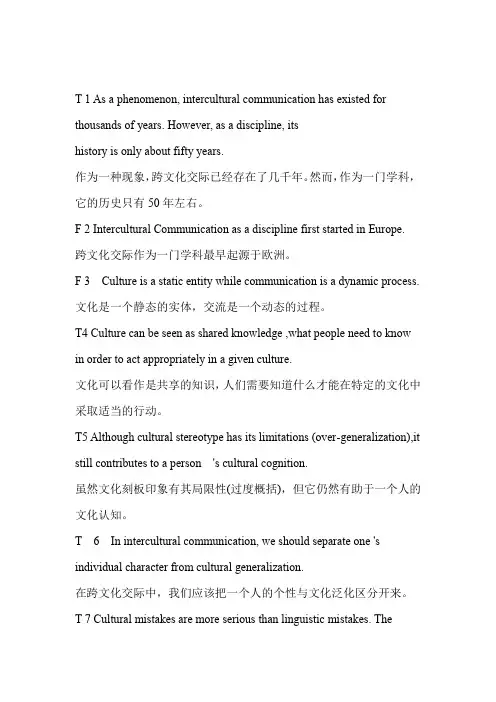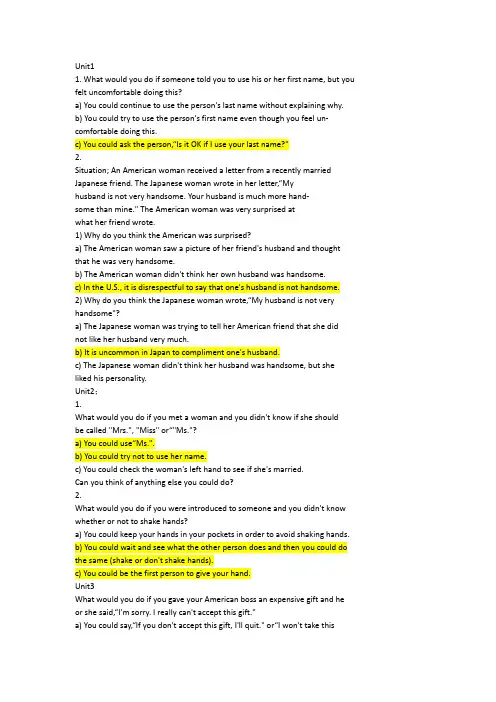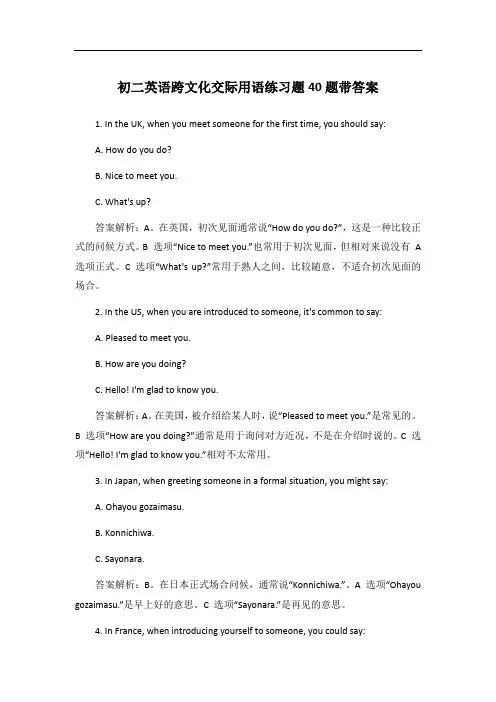跨文化交际实用教程 单词题
大学英语跨文化交际教程课后答案(全)

Unit1 Sportsmanship:It is the ability to practise a sport according to its rules, while also showing generosity to one’s opponent and good temper in defeat.2. Traditionally, an Englishman is thought to be reserved, unemotional, courteous, shy of strangers, suspicious of change, and slow to accept new ideas.3.It is the ability to practise a sport according to its rules, while also showing generosity to one’s oppo nent and good temper in defeat. Moreover, sportsmanship as an idea is applied to life in general.The pioneering spirit:Except for the brought from Africa, immigrants came to America voluntarily, early in search of greater prosperity and freedom.Rags-to-riches:It is story about a poor boy who, because he was hardworking, honest, and lucky, grew up to become rich and respected.American dream: The belief that any individual, no matter how poor, can achieve weather and fame through diligence and virtue.1.Traditionally, individualism, independence and collaboration, practice, tolerance, melting pot and racial discrimination are the character of Americans.3.The American Dream is the belief that any individual, no matter how poor, can achieve wealth and fame through diligence and virtue.Unit 2 Key concepts Five relationships Five relationships: ruler-minister, father-son, husband-wife, elder-younger brother and friend-friend.Humanism Humanism means that man not only had the right to enjoy the beauty of their life, but also had the ability to perfect themselves and perform wonders. Individualism An individualism culture is one in which people tend to view themselves ad individuals and to emphasize the needs of individuals.Collectivism A collectivism culture is one in which people tend to view themselves as members of groups (families, work units, tribes, nations), and usually consider the needs of the group to be more important than the needs of individuals. Comprehension questions1.According to Confucianism, what are the five cardinal relationships in Chinese society and what should these relationships be?That is the well-known five relationships: ruler-minister, father-son, husband-wife, elder-younger brother and friend-friend. This was explained as" There should be affection between man and wife, stratification between old and young, and good faith between friends."2.What is the difference between collectivism and individualism?Firstly, westerns tend to believe that people should rely on themselves as much as possible- and they usually expect other people to do the same. So they don't think they have the obligation to help family members and friends during emergency situations. In contrast, people in collectivist cultures generally feel that they have a right to help other members of their groups.Secondly, westerns generally feel that the rights of individuals should not be subordinated to the needs of a larger group, or at least that individuals should have the right to decide for themselves whether to sacrifice their personal benefit for the sake of the group. In contrast, people in collectivist cultures are generally more willing to accept the idea that individuals should sacrifice for the benefit of the group.Thirdly, westerners tend to believe that individuals should make decisions for themselves, and that individuals should take credit and responsibility for what they have personally done. In contrast, people in collectivist cultures tend to feel more that they are representatives of their group, and to accept more responsibility for the other members of their groups too.A final difference lies in the way people in different cultures view the idea of "individualism". Westerners tend to view individualism as a good thing. In contrast, the Chinese term for "individualism", often has a somewhat negative connotation, and is sometimes used as a synonym for "selfishness."Unit3 Nuclear family: include a husband, a wife and their childrenExtended family: adult couples are expected to form their own household with either of their biological families.2. Because they desire a close and intense bond with their partners,they expect so much from marriage that so many get divorcedImpermanence: the property of not existing for indefinitely long durations. Stable: resistant to change of position or conditionConnection vs. contract: relationship4. ①Chinese are likely to react more to the other person as a whole and will avoid forming friendships with those values and behaviors are in some way deemed undesirable. ②In China a friend is accepted completely or not at all ③Chinese friends give each other much more concrete help and assistance than Western friends do.①American have casual, friendly relationships with many people, but deeper, closer friendships with only a few. ②American friendships tend to be very compartmentalized. ③American friendships is mostly a matter of providing emotional support and spending time together.Unit5 Nutrition and balance: a look at the nutritional information, like the number of calories preserving, grams of fat, sodium, cholesterol, fiber and sugar content will make you more knowledgeable in selecting foods to reduce your nutritional health risk.Pragmatism:in the westerns’ eyes, food or eating is just a way to keep healthy, having little to do with artistry. Nor will they be particular about the taste of food too much.Unit6 Creativity: the ability to createSelf-reliance: is a principal value of child rearing in middle-class American. Originality:1.How do the Chinese teach their children?A: Chinese teach their children by holding their handsHow do Americans do?A: On their own and even to discover new problem for which creative solutions are wanted.Can you find the theories supporting the two different teaching method?A: Evolutionary and revolutionary2. Can you tell any other differences between the two educational systems?A: The contrast between the two cultures can also be seen in the fears we both harbor. Chinese teachers are fearful that if skills are not acquired early, they may never be acquired; there is, on the other hand, no comparable hurry to promote creativity.American educators fear that unless creativity has been acquired early, it may never emerge; on the other hand, skills can be picked up later.Unit7 Key concepts Monochronic time Monochronic time is an approach that favors linear structure and focus on one event or interaction at a time.Polychronic time A polychronic time system is a system where several things can be done at once, and a more fluid approach is taken to scheduling time. Unlike Americans and most northern and western European cultures, Latin American and Arabic cultures use the polychromic of time.Linear structure In monochromic time, linear structure means people focus on one event or interaction at a time.Schedule oriented People in polychronic time cultures treat time as a less tangible medium so that they can interact with more than one person or do more than one thing at a time.People oriented Polychronic individuals are oriented toward people, human relationships, and the family, which is the core of their existence. Family takes precedence over everything else, close friends come next..Comprehension questionsWhat is monochronic culture? What is polychronic culture?Monochronic cultures typically emphasize doing one thing at a time during a specified time-period, working on a single task until it is finished.Polychronic cultures are involved with many things at once, usually with varying levels of attention paid to each.What are the different attitudes monchronic people and polychronic people hold toward time?Monochronic people see time as being divided into fixed elements (seconds, minutes, hours, etc.)Sequential blocks that can be organized, quantified, and scheduled.What are the strengths and weaknesses of M-time system and P-time system?Once the time is set, it is rarely changed, and people take it seriously. M-time cultures is one who violates the rule of punctuality shall be punished seriously. Matters in a polychronic plans for the future: even important plans maybe changed right up the minute of execution.Unit 9Key concepts High-context culture High context cultures rely on the context, either the actual physical environment of communication or an internalized social context or both, or convey a large part or even all of a message’s meaning.Low-context culture Low context culture, in which context is not assumed to be understood, messages are explicit, direct, and completely encoded in words, and meaning is entrusted almost entirely to words.ImplicitnessThe message which someone expressed is elliptical, indirect, and allusive. Explicitness The message which someone expressed is direct, and completely encoded in words, and meaning is entrusted almost entirely to words..Verbalizing Verbalizing- that is, to put things in words, whether written or oral. Comprehensive questionsWhat is High-context culture? What is Low-context culture?High context cultures rely on the context, either the actual physical environment of communication or an internalized social context or both, or convey a large part or even all of a message’s meaning.Low context culture, in which context is not assumed to be understood, messages are explicit, direct, and completely encoded in words, and meaning is entrusted almost entirely to words.ImplicitnessWhat does silence mean in high-context cultures? What is the function of silence in high-context cultures?It means entirely accepted.In the individual level, silence can be viewed as a state of being allowing you to experience the highest truth and bliss; on the interpersonal level, silence can be used to promote harmony, cooperation, and other collectivistic values; on the level of social movements, silence can be protest.Why does silence mean differently in different cultures?Different in the uses of silence can be best examined in high-context and low-context cultures. High-context cultures are relational, collectivist, intuitive, and contemplative. Low-context cultures are logical, linear, individualistic, and action-oriented.Key conceptsCulture shock Culture shock happens to people who have been suddenly transplanted abroad. It is, first and foremost an emotional phenomenon; then comes cognitive disorientation and identity dissonance.Comprehension questionsWhat are the five stages of the cultural adjustment process? Does everyone have the same experience?The five stages of the cultural adjustment process:Honeymoon period: Initially many people are fascinated and excited by everything of the new culture.Culture shock: The individuals are immersed in news problems: housing, transportation, employment, shopping, and language.Initial adjustment: Everyone activities such as housing and shopping are no longer major problems. The visitors may not yet be fluent in the spoken language, but they can express their basic ideas and feelings.Mental isolations: Individuals away from their family and good friends for a long time may feel lonely.Acceptance and integration: A routine ( eg; work, business, or school) has been established. The newcomer has become accustomed to the habits, customs, foods, and characteristics of the people in the new culture.Individuals experience the stages of adjustment in different ways. Some people never experience a “honeymoon” period because the circumstances of their coming to a new country may have been too painful. In addition, certain stages last longer for some than for others, dep ending on such factors as the newcomer’s personality, age, language and cultural competence, support from family and friends, financial situation, job status, and motivations for being in the new country.。
完整word版跨文化交际实用教程胡超版U1 U8判断题答案及翻译

T 1 As a phenomenon, intercultural communication has existed for thousands of years. However, as a discipline, itshistory is only about fifty years.作为一种现象,跨文化交际已经存在了几千年。
然而,作为一门学科,它的历史只有50年左右。
F 2 Intercultural Communication as a discipline first started in Europe.跨文化交际作为一门学科最早起源于欧洲。
F 3 Culture is a static entity while communication is a dynamic process. 文化是一个静态的实体,交流是一个动态的过程。
T4 Culture can be seen as shared knowledge ,what people need to know in order to act appropriately in a given culture.文化可以看作是共享的知识,人们需要知道什么才能在特定的文化中采取适当的行动。
T5 Although cultural stereotype has its limitations (over-generalization),it still contributes to a person 's cultural cognition.虽然文化刻板印象有其局限性(过度概括),但它仍然有助于一个人的文化认知。
T 6 In intercultural communication, we should separate one 's individual character from cultural generalization.在跨文化交际中,我们应该把一个人的个性与文化泛化区分开来。
跨文化交际实用教程 复习 culture puzzle

Unit11. What would you do if someone told you to use his or her first name, but you felt uncomfortable doing this?a) You could continue to use the person's last name without explaining why.b) You could try to use the person's first name even though you feel un- comfortable doing this.c) You could ask the person,“Is it OK if I use your last name?"2.Situation; An American woman received a letter from a recently married Japanese friend. The Japanese woman wrote in her letter,“Myhusband is not very handsome. Your husband is much more hand-some than mine." The American woman was very surprised atwhat her friend wrote.1) Why do you think the American was surprised?a) The American woman saw a picture of her friend's husband and thought that he was very handsome.b) The American woman didn't think her own husband was handsome.c) In the U.S., it is disrespectful to say that one's husband is not handsome.2) Why do you think the Japanese woman wrote,“My husband is not very handsome"?a) The Japanese woman was trying to tell her American friend that she didnot like her husband very much.b) It is uncommon in Japan to compliment one's husband.c) The Japanese woman didn't think her husband was handsome, but she liked his personality.Unit2;1.What would you do if you met a woman and you didn't know if she shouldbe called "Mrs.", "Miss" or“"Ms."?a) You could use“Ms.".b) You could try not to use her name.c) You could check the woman's left hand to see if she's married.Can you think of anything else you could do?2.What would you do if you were introduced to someone and you didn't know whether or not to shake hands?a) You could keep your hands in your pockets in order to avoid shaking hands.b) You could wait and see what the other person does and then you could do the same (shake or don't shake hands).c) You could be the first person to give your hand.Unit3What would you do if you gave your American boss an expensive gift and he or she said,“I'm sorry. I really can't accept this gift."a) You could say,“If you don't accept this gift, I'll quit." or“I won't take thisclass anymore.b) You could try to find out his or her reasons for not accepting the gift.c) You can insist many times on giving the gift until he or she accepts it.U.S. Cultural Note: Most of the time Americans do accept gifts that peoplegive to them. However, in the workplace, bosses sometimes feel uncomfort-able accepting gifts and are not always allowed to do so. The following aresome of the reasons:-They do not want to feel that they have to do something special ordifferent for the employee who gives the gift.-They don't want the other employees to think that they have favoritesamong the employees.They may find it difficult to criticize their employee's work if they'vejust received a gift from him or her.Many companies have a policy saying that the boss is not allowed toaccept gifts from employees.2.Situation: (Joe and Gary, both Americans, are friends. They have just runinto each other at a store.)Joe: Hey, Gary, How've you been? (Joe is happy to see Gary, He slaps himon the back.)Gary: Oh, hi, Joe. How's it going? (Gary does not seem happy to see Joe.)Joe: Pretty good. Everything okay with you? It looks like something isbothering you.Gary: If you want to know the truth, I'm pretty angry at you.Joe: What did I do?Gary: Well, I heard that you went out with Jennifer two nights ago. You knowI've had my eye on her for a long time.What do you think Joe's reaction will be?a) Joe will apologize and will promise not to go out with Jenifer again.b) Joe will say something like,“Wait a minute. You don't own her. You'venever been out with her before."c) Joe will get angry with Gary because Gary got angry with him.U.S. Cultural Note: Americans often ask each other, “What's wrong?" ifthey see a person's expression showing that something is bothering him orher. Many people think that you should say what is wrong instead of justacting upset or angry. If a person acts upset, angry, or bothered, but doesn'tsay anything about it, some Americans think that person is being childish.Unit4What would you do if a stranger pronounced your name incorrectly? First, think about what you would do in your own language and culture, and thenwhat you would do if you were talking in English with an American.a) You wouldn't say anything.”b) You would say,“Excuse me, but my name s..".c) You would not say,“Excuse me." You would just say, "'..unit5Situation: An American invited a group of Japanese students over to his house. He and his wife had spent a great deal of time preparing food andgetting the house ready. They were looking forward to the party andhoped that the Japanese would enjoy themselves. They came at about8:00 at night and right away seemed to be enjoying themselves.There was a lot of dancing and singing and good conversation. Then,almost suddenly, one of the students said "Thank you'" to the hostsand said that it was time to go. After that, all of the Japanese began toget ready to leave. The American and his wife couldn't understandwhy this happened. They felt insulted because everyone left so earlyand at the same time.Can you explain what happened?a) The Americans must have done something that offended the Japanese.b) The Japanese were not having a good time.c) Japanese usually leave as a group and try not to stay too long so as not to offend their host.Unit6Background: Janice, an American businesswoman, and Maya, a business- woman from Mexico, both work for the same company. Maya has just come to the U.S. to work in the American office of her company. Below are several situations involving Janice and Maya.In the following cultural puzzles, circle the letter before the nonjudgmental questions that will help Maya get the most helpful answers. After you choose the best question for each situation, read the U.S. Cultural Notethat explains the American behavior,1.Situation: Maya is introduced to Janice. Maya notices that Janice often smiles as she talks to the men and women in the company. In Maya'sculture, a woman who smiles frequently when she tallks to men isprobably flirting. Maya asks a co-worker from her own culture:a) Janice is not a good woman, is she?b) Why does Janice flirt with strange men?c) What does it mean when an American woman smiles at a man?°U.S. Cultural Note: Americans, especially American women, smile more than people from many other cultures. The smile is usually just a sign of friendliness.2.Situation: Maya and Janice are having lunch. Maya cuts her hand while sheis opening a soft drink can. She says,“Oh, that hurts!" Janice says,“T'm sorry! Are you all right?" Later Maya says to a friend from her country:a) Why do Americans act like any problem is their fault?b) Do Americans feel that it is their fault when someone gets hurt using anAmerican product?c) When I cut my hand, Janice said, 'T'm sorry.' It wasn't her fault. Do mostAmericans apologize when it' s not their fault?U.S. Cultural Note: Some Americans say,“T'm sorry" if others tell them sadnews or that someone is hurt. The American means,“I' m sorry about whathappened. I feel sympathy for you." In this case,“T'm sorry is not an apology.3.Situation: Maya sees the president of her company (an American) serve somecoffee to a visitor. In her country, a company president wouldalways ask a secretary to perform tasks like that. She asks Janice:a) I saw the company president serve coffee to a visitor. For me, that was veryunusual. Does that seem unusual to you?b) Don't American secretaries like to take care of their bosses?c) Is the president' s secretary sick?4.Situation: Maya visits Janice' s house one Saturday afternoon. She is listeningto a conversation the family is having. Janice, her husband and thechildren are discussing where to go for their summer holiday.Janice wants to go to New York City, but the children want to go camping instead. Janice listens carefully to the children's reasons.Later, Maya asks another American:a) Why do American children have so much power in the American family'?b) Why do American parents let their children tell them what to do?c) Do Americans often let their children help make decisions?U.S. Cultural Note: Americans often encourage their children to express anddefend their opinions in family decision-making. Parents feel this helps thechildren learn to express their ideas clearly.。
初二英语跨文化交际用语练习题40题含答案解析

初二英语跨文化交际用语练习题40题含答案解析1.When Mary meets Tom for the first time, she says, “________”.A.Hello! Nice to meet you!B.How are you?C.Good morning!D.Goodbye!答案解析:A。
在初次见面的场景中,通常用“Hello! Nice to meet you!”来打招呼表示很高兴认识对方。
B 选项“How are you?”一般用于熟人之间询问近况。
C 选项“Good morning!”用于早上打招呼。
D 选项“Goodbye!”是告别用语。
2.Jack is from America. When he meets his Chinese friend Li Hua, he may say, “________”.A.こんにちは!B.Hi! How are you doing?C.Bonjour!D.Guten Tag!答案解析:B。
“Hi! How are you doing?”是美国人常用的打招呼方式。
A 选项是日语“你好”。
C 选项是法语“你好”。
D 选项是德语“你好”。
3.A Japanese student meets a British student. The Japanese student may say, “________”.A.Hello! Nice to see you.B.Ohayo!C.Good afternoon!D.Hallo!答案解析:A。
在跨文化交际中,“Hello! Nice to see you.”比较通用。
B 选项“Ohayo!”是日语“早上好”。
C 选项“Good afternoon!”是下午打招呼用语。
D 选项“Hallo!”是德语“你好”。
4.When a Canadian meets an Australian, they may start the conversation with “________”.A.G’day!B.Hello! What’s up?C.Bonjour!D.Hi! How’s it going?答案解析:D。
初二英语跨文化交际用语练习题40题(答案解析)

初二英语跨文化交际用语练习题40题(答案解析)1.When you meet a person for the first time in the UK,what would you say?A.How are you?B.Nice to meet you.C.Good morning.D.Hello.答案解析:B。
在英国,初次见面通常会说“Nice to meet you.”表示很高兴认识对方。
“How are you?”一般用于熟人之间问候。
“Good morning.”和“Hello.”比较随意,不太适合初次见面的场合。
2.In the US,if someone asks you“How are you?”,what is the common response?A.I'm fine,thank you.B.Very well,thanks.C.Not bad.D.Good.答案解析:A。
在美国,当别人问“How are you?”时,最常见的回答是“I'm fine,thank you.”。
“Very well,thanks.”“Not bad.”和“Good.”也可以,但不如“I'm fine,thank you.”正式和常用。
3.When introducing yourself to a Japanese person,what would you start with?A.Hi,I'm...B.My name is...C.I am...D.Hello,my name is...答案解析:B。
在日本,介绍自己时通常会说“My name is...”比较正式。
“Hi,I'm...”“I am...”和“Hello,my name is...”比较随意,不太适合正式场合。
4.In China,when you meet an elder person for the first time,what would you say?A.Nice to meet you.B.How are you?C.Respectfully greetings.D.Hello.答案解析:C。
初二英语跨文化交际用语练习题40题带答案

初二英语跨文化交际用语练习题40题带答案1. In the UK, when you meet someone for the first time, you should say:A. How do you do?B. Nice to meet you.C. What's up?答案解析:A。
在英国,初次见面通常说“How do you do?”,这是一种比较正式的问候方式。
B 选项“Nice to meet you.”也常用于初次见面,但相对来说没有 A 选项正式。
C 选项“What's up?”常用于熟人之间,比较随意,不适合初次见面的场合。
2. In the US, when you are introduced to someone, it's common to say:A. Pleased to meet you.B. How are you doing?C. Hello! I'm glad to know you.答案解析:A。
在美国,被介绍给某人时,说“Pleased to meet you.”是常见的。
B 选项“How are you doing?”通常是用于询问对方近况,不是在介绍时说的。
C 选项“Hello! I'm glad to know you.”相对不太常用。
3. In Japan, when greeting someone in a formal situation, you might say:A. Ohayou gozaimasu.B. Konnichiwa.C. Sayonara.答案解析:B。
在日本正式场合问候,通常说“Konnichiwa.”。
A 选项“Ohayou gozaimasu.”是早上好的意思。
C 选项“Sayonara.”是再见的意思。
4. In France, when introducing yourself to someone, you could say:A. Bonjour! Je m'appelle...B. Salut! Je suis...C. Au revoir! Je m'appelle...答案解析:A。
新编跨文化交际英语教程课后练习题含答案
新编跨文化交际英语教程课后练习题含答案介绍跨文化交际英语教程是针对外语专业学生开设的一门课程,旨在培养学生跨越语言和文化差异的能力。
本文档是新编跨文化交际英语教程的课后练习题,含有答案。
练习题Unit 1 练习题1.What is culture? How does it affect communication?2.Can you give some examples of cultural differences betweenChina and your country?3.Why is it important to be aware of cultural differences incommunication?4.What are the advantages of studying cross-culturalcommunication?5.What are the challenges of cross-cultural communication?答案1.Culture refers to the shared values, beliefs, customs,behaviors, attitudes, and artifacts that characterize a group orsociety. Culture can affect communication in many ways, such asthrough differences in language, nonverbal cues, social norms, and power structures.2.答案根据不同国家而异。
1。
跨文化交际实用教程Unit1精品PPT课件
very tired. You’re old… Catherine (an elderly American lady):
Oh, I’m NOT old, and I’m NOT tired.
5
In the West: A: How are you doing now? Would you
like to rest? B: No, not a bit.
批注本地保存成功开通会员云端永久保存去开通
Intercultural Communication
A Practical Coursebook
跨文化交际实用教程
1
Unit 1 An Introduction
2
Objectives
Learn the purpose of learning the course.
20
3) Culture is an Integrated system of learned behavior patterns which are characteristic of the members of a society and which are not the result of biological inheritance.
新编跨文化交际英语教程测试题(三)
跨文化交际测试题(三)I. Multiple Choice(20 points, 2 points each)Directions: There are some statements in this section. For each statement there are four choices marked A, B, C and D, choose the ONE that best completes the statement.1._____ is the process of putting an idea into a symbol.A. DecodingB. ChannelC. EncodingD. Source2._____ is the socialization process you go through to adapt to your society.A. DeculturationB. AcculturationC. AssimilationD. Enculturation3._____ takes place when individuals become an integral part of the new culture while maintaining their cultural integrity.A. Culture shockB. IntegrationC. Cultural identityD. Acculturation4.An American company that operates in Japan almost caused a disaster in the United States—Japanese relations by addressing 500 red Christmas cars to its Japanese joint-venture partner, since funeral notices are red in Japan. This case has reflected that each country has its art for _____.A. tippingB. greetingC. card exchangeD. giving gift5.In______, the handshake is accompanied with a light kiss; even males kiss both cheeks after a handshake.A. the United StatesB. Saudi ArabiaC. RussiaD. France6._____ occurs when the sender and the receiver exchanging messages are from different races that pertain to different physical characteristics.A. Interethnic CommunicationB. Interracial CommunicationC. Intracultural communicationD. Intercultural communication7._____ is typically used to refer to the study of a particular idea or concept within many cultures. The goal of such investigations is to conduct a series of intracultural analyses in order to compare on culture to another on the attributes of interest.A. Interethnic communicationB. Interracial communicationC. Cross-cultural communicationD. Intercultural communication8._____ refers to communication between people whose cultural perceptions and symbol systems are distinct enough to alter the communication event.A. Interethnic CommunicationB. Interracial CommunicationC. intracultural communicationD. Intercultural communication9._____ refers to anything that distorts the message the source encodes.A. NoiseB. MessageC. SourceD. Context10._____ refers to that portion of the receiver response of which the source has knowledge and to which the source attends and assigns meaning.A. ReceiverB. DecodingC. EncodingD. FeedbackII. Terms (15 points, 3 points each)Directions: There are five terms in this section. Try to explain the following terms in your own words. Then write down the answers on the Answer Sheet.11.Intracultural communication12.Nonverbal communication (from narrow perspective)13.High context14.Stereotype15.PrejudiceIII. Case Analysis(20 points, 5 points each)Directions: In this section you are supposed to analyze the following cases from the perspective of intercultural communication. Then write down the answers on the Answer Sheet.16.Automaker Henry Ford established for his company the “English Melting Pot School.” The graduation ceremony featured the automaker’s foreign-born employees, dressed in Old World costumes and carrying signs noting their birthplaces, marching into a large, kettle-shaped prop labeled “Melting Pot.” Moments later, the same people would emerge dressed in neat business suits and waving small U.S. flags.17. A speaker’s use of uncalled-for profanity can cause us to wonder why the speaker used profanity and draw attention away from the message itself.18.You have certain knowledge and expectations of the communication that occurs within synagogues, mosques, and churches. At times, you intentionally plan a certain physical environment for your communication: you may want to locate your romantic communications ina quiet, dimly lit restaurant or on a secluded beach.19.Korean has special vocabularies for each sex, for different degrees of social status and degrees of intimacy, and for formal occasions. When two people are introduced, they first engage in small talk to determine each other’s social position in order to know who should use common language and who should use honorific language.IV. Short Answer(30 points, 5 points each)Directions: In this section you are supposed to answer the following questions with the knowledge of intercultural communication.Then write down the answers on the Answer Sheet.20.What are key strategies for effective intercultural communication?21.What are the elements contributing to the globalization?22.How is culture learned?23.How many stages can be the process of perception divided? What are they?24.Describe four reasons for the persistence of prejudice?25.Explain the term “intercultural communication competence” and its three components.V.English—Chinese Translation(15 points, 3 points each)Directions: In this section you are supposed to translate the underlined sentences into Chinese.Then write down the answers on the Answer Sheet.26. Good intercultural communicators must have intercultural communication competence. Communication competence is a part of social competence, which is an individual’s ability, i.e. behaviors and skills, to control his or her social environment. 27. Intercultural competence is a part of communication competence. Communication competence is the competence in general, while the intercultural communication involves the communication between communicators from different cultural backgrounds. 28. To be a successful intercultural communicator, we must know the components of intercultural competence. First, competent intercultural communication is contextual. Competence is not independent of the relationships and situations within which communication occurs. 29. Secondly, intercultural competence requires behaviors that are appropriate and effective. 30. Thirdly, intercultural competence requires sufficient knowledge, suitable motivations, and skilled actions.。
跨文化交际-Unit_1
Word Combinations pushy
trying constantly to draw attention to oneself and gain an advantage; self-assertive 爱讨便宜的;坚持己见的;一意孤行的 e.g. He made himself unpopular by being so pushy. 他特别喜欢一意孤行,所以人缘不好。
Word Combinations
lie in ① (of abstract things) exist or be found
(指抽象事物)存在,在于 e.g. I only wish it lay within my power to help you. 我但愿能够帮助你。 e.g. The cure for stress lies in learning to relax. 消除紧张的办法在于学会放松。 e.g. It’s obvious where our interest lies. 我们的利益所在是明摆着的事情。 ② (Bri.) = (US) sleep in stay in bed after the normal time for getting up 睡懒觉 e.g. It’s a holiday tomorrow, so you can lie in. 明天是假日,你可以睡懒觉了。
Effective I.C.
• One aspect of effective I.C. is ensuring that messages are communicated accurately. As Gundykunst (1998) writes : “To communicate effectively, we must transmit our messages in a way that strangers [people of other cultural backgrounds] can understand what we mean, and we need to interpret strangers’ message in the way they meant them to be interpreted.” • However, as Lustig and Koester (1996) point out, effective I.C. requires more than simply getting one’s message across; it also requires communicating in ways that are considered appropriate by the involved parties and don’t result in unnecessary offense.
- 1、下载文档前请自行甄别文档内容的完整性,平台不提供额外的编辑、内容补充、找答案等附加服务。
- 2、"仅部分预览"的文档,不可在线预览部分如存在完整性等问题,可反馈申请退款(可完整预览的文档不适用该条件!)。
- 3、如文档侵犯您的权益,请联系客服反馈,我们会尽快为您处理(人工客服工作时间:9:00-18:30)。
1. If the economic strength of townships is improved, they will become a strong magnet to attract and surplus rural labor. A) aggravate B) segregate C) assimilate D) initiate 2. This research will be used to make advances in robotic technologies and smoother interactions between humans and robots. A) facilitate B) terminate C) frustrate D) validate 3. This will be a decision for the education services because it sets the standards for future years. A) commercial商业 B) convertible 可转换 C) compatible 兼容的 D) crucial重要的 4. What impresses us the most about Philadelphia is that despite its horrible reputation, at least in the world of sports, the residents are friendly and . A) ignorant B) conspicuous 引人注目 C) aggressive 积极地 D) courteous彬彬有礼的 5. The government wanted to take better care of the elderly so new facilities are being added to the special needs of elderly residents. A) accommodate 适应 B) convert 转换 C) manipulate 操作 D) allocate分配 6. He was being critical when he called me a workaholic, but I took it as a and didn’t feel insulted. A) supplement 补充 B) compliment 称赞 C) component 组件 D) substitute替代 7. He was presently awakened by something which at first he could not determine to be a noise or a (n) sensation. A) susceptible 敏感 B) sustainable可持续 C) intangible 无形 D) incredible邻人难以置信 8. She seems completely unaware of the contradictions in her professed point of view, leaving the audience totally baffled. A) inherent 固有的 B) coherent 一致的 C) incidental 偶然 D) superficial表面 9. After college, many young people may initially work at jobs that do not require a college degree. This makes it tricky to graduate employment statistics. A) inaugurate B) intimidate 胁迫 C) interpret 解释 D) insulate 隔离 10. Republicans almost uniformly oppose the climate change bill, and have an alternative plan calling for 100 new nuclear plants. A) put down 放下 B) put out 扑灭 C) put off 推迟 D) put forward提出
Unit2 1. With other scanners, this step may simply reveal the ports, services, and applications running so that the software can ________ to the next step. A) provoke B) proceed C) propel D) prohibit 2. My sister, in turn, would be amazed with both the depth and excitement of my experience, as well as my ________ in thinking of the stories as nothing special. A) maintenance B) meditation C) modesty D) majesty 3. This ________ was laid out in one of the farm’s “regular homes”, but the country still cannot feed its people and is reliant on international food aid. A) bachelor B) benefit C) bandage D) banquet 4. Such was the breezy optimism of many of the advocates that an alien landing in Manchester Town Hall might have wondered what all the ________ over global warming was about. A) flush B) fuss C) forum D) freight 5. The area where the most striking evidence for the influence of language on thought has come to light is the language of space — how we describe the ________ of the world around us. A) obligation B) representation C) orientation D) innovation 6. My instincts were to release the records and fight the prosecutor, but if the consensus was to do the ________, I could live with it. A) reverse B) resignation C) refreshment D) reservation 7. If you’re having trouble varying your responses, pick several ________, formal phrases, such as “Right away”, “I will” and/or “Yes, certainly”, and stick to those. A) novel B) notorious C) negative D) neutral 8. The employers and the trade union leaders are still poles apart, and are far from reaching an agreement or ________. A) commission B) compromise C) combustion D) commodity 9. Despite this guy’s ________, this scene gave me time to reflect on how drink names appear often throughout cocktail history, sometimes with similar ingredients and sometimes vastly different. A) analogy B) assessment C) arrogance D) anniversary 10. The findings of this sociologist are very interesting because they ________ once again the relationship that exists between what we do in the present and the results we obtain in the future. A) implement B) impart C) implore D) illustrate
Unit3 1. His life was as romantic and colorful as his ________ music, yet his works are rarely performed today. A) exquisite B) requisite
